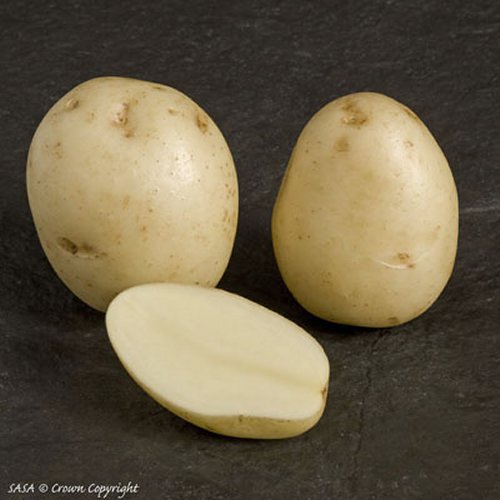Swift is a First Early potato variety and as the name implies they produce one of the earliest potato crops of all varieties. Some claim that when Swift are chitted and planted at the correct time they will produce a crop in seven weeks, but nine to ten weeks is probably more realistic.
Swit was bred by the Caithness Potato Breeders in Scotland and first released in 1994.
The potatoes are oval with light brown and thin skins which do not really need peeling They have a few shallow eyes and they look exactly how a top quality new potato should look. The flesh is light yellow and has excellent flavour.
They are ideally suited for container growing because the plants are short and compact, they also thrive in windy conditions. Swift was given the RHS Award of Garden Merit (AGM) in 2003.
Their principal use is as a boiled (or steamed) potato either eaten hot or in salads. They do not store well, 10 days at the most, so only grow as many as you can eat or give away within a couple of weeks.
Although they can remain in the soil a couple of weeks after harvest is due the skin will then thicken up slightly and blight may become a problem.
They have low resistance to blight but that is unlikely to be a problem because Swift will have reached maturity before blight can cause a problem. Other pest and disease resistance is good, especially to scab.

Swift Potato
Swift potatoes should be grown in the normal manner for First Early potatoes. Click here for our detailed page about growing potatoes. The advice applies to growing potatoes in containers as well as in open ground.
The best time to chit / sprout Sift potatoes is the first week of March in average areas of the UK.
Being a First Early variety it is definitely worth chitting / sprouting Swift potatoes - it will give a more reliable crop although not absolutely necessary. Click here for our advice on how and why to chit / sprout potatoes.
The best time to plant out chitted / sprouted Swift potatoes is about the first week of April in average areas of the UK.
Planting out on this date will give the chitted / sprouted potatoes about four weeks before they reach the surface of the soil. Whilst they are growing towards the soil surface the sprouts will be protected from frost by the surrounding soil.
By the time they do appear above the soil, the danger of frost will have passed and the sprouts will not be damaged by frost.
As with all vegetables, the time for harvest is dependent on many factors such as the weather conditions while they are growing and the general soil conditions.
On average however you can expect to start harvesting Swift potatoes in the third week of June in average areas of the UK.
Using the above date as a guide we would advise that a week before that date you use your hand to search through the soil to harvest one or two potatoes.
The term often used for this activity is known in gardening circles as "furtling"! The potatoes are best harvested when they are the size of a large hen egg.
It does almost no damage to the remaining potatoes but allows you to examine one or two of the potatoes to ensure they are of approximately the correct size. If they are, start harvesting, if not wait for a week or two and try again.
Harvesting Swift potatoes can be spread over ten days. First Early potatoes do not store for very long so be sure to read our page on storing potatoes to get the most from your crop of Swift potatoes.
For other second early potatoes we have tested, select one from the drop down list below.
IF YOU HAVE ANY QUESTIONS OR COMMENTS
CONCERNING THIS PAGE, ENTER THEM BELOW.
WE WILL ANSWER ON
THIS PAGE AS SOON AS POSSIBLE